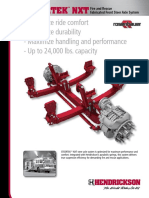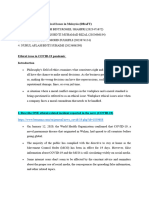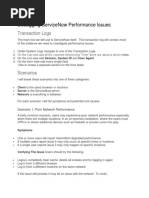0 ratings0% found this document useful (0 votes)
38 viewsChapter 2
The document discusses international trade and protectionism. It explains that free trade benefits participating countries by providing access to new markets and customers. However, governments also impose trade barriers like tariffs and quotas to protect local industries. The trends has been toward more open trade through agreements like the General Agreement on Tariffs and Trade and World Trade Organization that aim to reduce barriers and resolve trade disputes. The document also discusses the balance of payments and role of the International Monetary Fund in facilitating trade.
Uploaded by
andinCopyright
© © All Rights Reserved
We take content rights seriously. If you suspect this is your content, claim it here.
Available Formats
Download as DOCX, PDF, TXT or read online on Scribd
0 ratings0% found this document useful (0 votes)
38 viewsChapter 2
The document discusses international trade and protectionism. It explains that free trade benefits participating countries by providing access to new markets and customers. However, governments also impose trade barriers like tariffs and quotas to protect local industries. The trends has been toward more open trade through agreements like the General Agreement on Tariffs and Trade and World Trade Organization that aim to reduce barriers and resolve trade disputes. The document also discusses the balance of payments and role of the International Monetary Fund in facilitating trade.
Uploaded by
andinCopyright
© © All Rights Reserved
We take content rights seriously. If you suspect this is your content, claim it here.
Available Formats
Download as DOCX, PDF, TXT or read online on Scribd
You are on page 1/ 3
CHAPTER 2 : THE DYNAMIC OF INTERNATIONAL MARKET
Regardless of the theoretical approach used in defence of international trade, it is
clear that the benefits from absolute or comparative advantage can accrue to any country.
Heightened competition around the world has created increased pressure for protectionism
from every region of the globe at a time when open markets are needed if world resources
are to be developed and utilised in the most beneficial manner for all. It is true that there
are circumstances when market protection may be needed and may be beneficial to
national defence or the encouragement of infant industries in developing countries, but the
consumer seldom benefits from such protection.
Free international markets help participating countries to become full members of
world markets and, because open markets provide new customers, most industrialised
nations have, since the Second World War, cooperated in working towards freer trade. Such
trade will always be partially threatened by various governmental and market barriers that
exist or are created for the protection of local businesses. However, the trend has been
towards freer trade. The changing economic and political realities are producing unique
business structures that continue to protect certain major industries
BALANCE OF PAYMENT
The system of accounts that records a nation’s international financial transactions is
called its balance of payments. A nation’s balance-of-payments statement records all
financial transactions between its residents and those of the rest of the world during a given
period of time – usually one year. Because the balance- of-payments record is maintained
on a double-entry bookkeeping system, it must always be in balance. Each of the nation’s
financial transactions with other countries is reflected in its balance of payments.
A nation’s balance of payments presents an overall view of its international eco-
nomic position and is an important economic measure used by treasuries, central banks and
other government agencies whose responsibility it is to maintain external and internal
economic stability.
A balance-of-payments statement includes three accounts: the current account – a
record of all merchandise exports, imports and services plus unilateral transfers of funds;
the capital account – a record of direct investment portfolio transactions, and short-term
capital movements to and from countries; and the official reserves account – a record of
exports and imports of gold, increases or decreases in foreign exchange, and increases or
decreases in liabilities to foreign central banks. Of the three, the current account is of
primary interest to international business.
PROTECTIONISM
Countries utilise legal barriers, exchange barriers and psychological barriers to
restrain entry of unwanted goods. Businesses work together to establish private market
barriers, while the market structure itself may provide formidable barriers to imported
goods. However, as effective as it is in keeping some products out of the market, in a legal
sense it cannot be viewed as a trade barrier.
Protection logic and illogic
Countless reasons are espoused by protectionists to maintain government
restrictions on trade, but essentially all arguments can be classified as follows:
- Ada 11
Trade Barriers
To encourage the development of domestic industry and protect existing industry,
governments may establish such barriers to trade as tariffs, quotas, boycotts,
monetary barriers, non-tariff barriers and market barriers. Barriers are imposed
against imports and against foreign businesses.
- Tariffs : is a tax imposed by a government on goods entering at its borders. Tariffs
may be used as a revenue-generating tax or to discourage the importation of
goods, or for both reasons. In addition, tariffs are arbitrary, discriminatory and
require constant administration and supervision. They are often used as reprisals
against protectionist moves of trading partners.
- Non-Tariffs barriers: imports are restricted in a variety of ways other than tariffs.
These non-tariff barriers include quality standards on imported products, sanitary
and health standards, quotas, embargoes and boycotts.
o Quota : limitations on the quantity of certain goods imported during a
specific period
o Voluntary Export Restrains : an agreement between the importing
country and the exporting country for a restriction on the volume of
exports
o Boycotts: a coordinated refusal to buy or use products or services of a
certain company/country
- Monetary Barriers: A government can effectively regulate its international trade
position by various forms of exchange-control restrictions. A government may
enact such restrictions to preserve its balance-of-payments position or
specifically for the advantage or encouragement of particular industries. Blocked
currency means cuts off all importing or all importing above a certain level;
accomplished by refusing to allow importers to exchange national currency for
the seller’s currency. The Differential exchange rate requires the importer to pay
varying amounts of domestic currency for foreign exchange with which to
purchase products. Government approval to secure foreign exchange is often
used by countries experiencing severe shortages of foreign exchange. Thus,
importers who want to buy a foreign good must apply for an exchange permit:
that is, permission to exchange an amount of local currency for foreign currency.
- Standards : Non-tariff barriers of this category include standards to protect
health, safety and product quality. The standards are sometimes used in an
unduly stringent or discriminating way to restrict trade, but the sheer volume of
regulations in this category is a problem in itself.
EASING TRADE RESTRICTION
As the global marketplace evolves, trading countries have focused attention on ways of
eliminating tariffs, quotas and other barriers to trade.
General Agreement on Tariffs and Trade (GATT):
Although not all countries participated, this agreement paved the way for the first
effective worldwide tariff agreement. The original agreement provided a process to
reduce tariffs and created an agency to serve as watchdog over world trade. GATT’s
agency director and staff offered countries a forum for negotiating trade and related
issues. The panels were only advisory and had no enforcement powers. Equally
significant were the results of negotiations in the investment sector. Trade- Related
Investment Measures (TRIMs) established the basic principle that investment
restrictions can be major trade barriers. Another objective of the EU for the Uruguay
round was achieved by an agreement on Trade-Related Aspects of Intellectual
Property Rights (TRIPs). The TRIPs agreement establishes substantially higher
standards of protection for a full range of intellectual property rights than are
embodied in current international agreements, and it provides for the effective
enforcement of those standards both internally and at the border.
World Trade Organization (WTO):
The WTO is an institution, not an agreement as was GATT. It sets the rules governing
trade between its members, provides a panel of experts to hear and rule on trade
disputes between members. All member countries have equal representation in the
WTO’s ministerial conference, which meets at least every two years to vote for a
director-general who then appoints other officials. Trade disputes are heard by a
panel of experts selected by the WTO from a list. of trade experts provided by
member countries. The panel hears both sides and issues a decision; the winning
side is authorised to retaliate with trade sanctions if the losing country does not
change its practices. While the WTO has no actual means of enforcement,
international pressure to comply with WTO decisions from other member countries
is expected to force compliance.
International Monetary Fund (IMF):
formed to overcome market barriers such as inadequate monetary reserves and
unstable currency. While the IMF has some severe critics, most agree that it has
performed a valuable service and at least partially achieved many of its objectives.
To cope with universally floating exchange rates, the IMF developed special drawing
rights (SDRs), one of its more useful inventions. Some countries permit their
currencies to float cleanly without manipulation (clean float) while other nations
systematically manipulate the value of their currency (dirty float), thus modifying the
accuracy of the monetary marketplace. Although much has changed in the world’s
monetary system since the IMF was first established, it still plays an important role in
providing short-term financing to governments struggling to pay current-account
debts, and it will be instrumental in helping to establish free markets in emerging
markets.
You might also like
- MugShot of Paola Salgar Gonzalez. Doral, FLNo ratings yetMugShot of Paola Salgar Gonzalez. Doral, FL1 page
- Chapter 2: The Dynamic Environment of International TradeNo ratings yetChapter 2: The Dynamic Environment of International Trade24 pages
- Chapter 2: The Dynamic Environment of International TradeNo ratings yetChapter 2: The Dynamic Environment of International Trade24 pages
- The Dynamic Environment of International Trade: Mcgraw-Hill/IrwinNo ratings yetThe Dynamic Environment of International Trade: Mcgraw-Hill/Irwin30 pages
- Solution Manual For International Marketing 16th Edition Cateora 0073529974 9780073529974100% (55)Solution Manual For International Marketing 16th Edition Cateora 0073529974 978007352997436 pages
- Chap. 2. The Dynamic Environment of International Trade100% (1)Chap. 2. The Dynamic Environment of International Trade27 pages
- The 20 To The 21 Century First World War: TH STNo ratings yetThe 20 To The 21 Century First World War: TH ST11 pages
- The Dynamic Environment of International TradeNo ratings yetThe Dynamic Environment of International Trade14 pages
- International Marketing 16th Edition by Cateora Gilly and Graham Solution Manual PDFNo ratings yetInternational Marketing 16th Edition by Cateora Gilly and Graham Solution Manual PDF9 pages
- Chapter 2 The Dynamic Environment of International TradeNo ratings yetChapter 2 The Dynamic Environment of International Trade49 pages
- Türkçe Öğreniyoruz 1 - Türkisch Aktiv 1 (PDFDrive)No ratings yetTürkçe Öğreniyoruz 1 - Türkisch Aktiv 1 (PDFDrive)7 pages
- International Marketing Chapter 2 Answers and SolutionNo ratings yetInternational Marketing Chapter 2 Answers and Solution2 pages
- International Marketing 15 Edition: The Dynamic Environment of International TradeNo ratings yetInternational Marketing 15 Edition: The Dynamic Environment of International Trade18 pages
- Acc. Management of international trade and financeNo ratings yetAcc. Management of international trade and finance17 pages
- Lecture 3: International Trade and AgreementNo ratings yetLecture 3: International Trade and Agreement5 pages
- The Dynamic Environment of International TradeNo ratings yetThe Dynamic Environment of International Trade17 pages
- What Is Meant by Protectionism?: Chapter Three: Protectionism and Free TradeNo ratings yetWhat Is Meant by Protectionism?: Chapter Three: Protectionism and Free Trade4 pages
- Get International Marketing 17th Edition Cateora Solutions Manual free all chapters100% (12)Get International Marketing 17th Edition Cateora Solutions Manual free all chapters48 pages
- Toddle 9bfb7930 0964 497c 9d18 e55a4e0ed408 Free Trade Fair Trade DocxNo ratings yetToddle 9bfb7930 0964 497c 9d18 e55a4e0ed408 Free Trade Fair Trade Docx4 pages
- 5.2 AFM Investment Appraisal International 231223No ratings yet5.2 AFM Investment Appraisal International 23122313 pages
- Import Vs Export: Refers To The Exchange of Products and Services From One Country To AnotherNo ratings yetImport Vs Export: Refers To The Exchange of Products and Services From One Country To Another35 pages
- Dynamic Environment of International TradeNo ratings yetDynamic Environment of International Trade35 pages
- Trade Barrier: Trade Barriers Are A General Term That Describes Any Government Policy or Regulation That RestrictsNo ratings yetTrade Barrier: Trade Barriers Are A General Term That Describes Any Government Policy or Regulation That Restricts3 pages
- 7.government Policy and International TradeNo ratings yet7.government Policy and International Trade16 pages
- Global Trade Mastery: A Practical Guide to Export ExcellenceFrom EverandGlobal Trade Mastery: A Practical Guide to Export ExcellenceNo ratings yet
- Verb To Be: 2. Write The Missing Words of The Verb To Be (Interrogative Form) : Affirmative100% (1)Verb To Be: 2. Write The Missing Words of The Verb To Be (Interrogative Form) : Affirmative1 page
- Social Problems Perspectives, Disaster ResearchNo ratings yetSocial Problems Perspectives, Disaster Research117 pages
- Memories of A Fragmented Nation - WP08 - Hassan100% (1)Memories of A Fragmented Nation - WP08 - Hassan19 pages
- Early Childhood Program Evaluations: A Decision-Maker's GuideNo ratings yetEarly Childhood Program Evaluations: A Decision-Maker's Guide12 pages
- Financial Accounting & Analysis: Ratio Analysis Siddharth S. KanungoNo ratings yetFinancial Accounting & Analysis: Ratio Analysis Siddharth S. Kanungo48 pages
- Hungarian as a Minority and Majority Language in Different Language Policy ContextsNo ratings yetHungarian as a Minority and Majority Language in Different Language Policy Contexts19 pages
- When Why and Where in Oral and Maxillofacial Surgery Part II 1st Edition by KC Gupta ISBN 8184483015 9789350259290 - The full ebook version is ready for instant download100% (10)When Why and Where in Oral and Maxillofacial Surgery Part II 1st Edition by KC Gupta ISBN 8184483015 9789350259290 - The full ebook version is ready for instant download87 pages
- HEV EV Electrical System Architecture 混合动力 纯电动车 高压电气系统架构No ratings yetHEV EV Electrical System Architecture 混合动力 纯电动车 高压电气系统架构18 pages

























































































